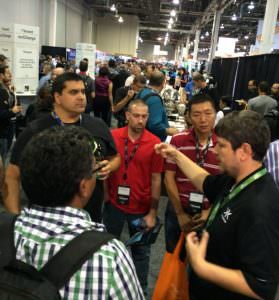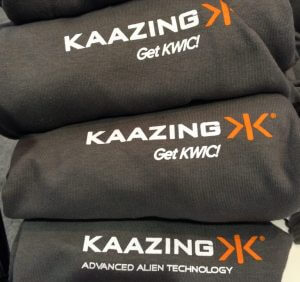Thoughts on AWS re:Invent 2015
“Nature is a mutable cloud which is always and never the same.
Ralph Waldo Emerson
“I never said most of the things I said.
Yogi Berra
 Let’s Get Real
Let’s Get Real
Just a few years ago, many industry pundits (aka “talking heads”) proclaimed in-person conferences were dead. And trade shows and industry conferences would only be experienced in Second Life by your avatar who would learn more than you and eventually take over your job. What we didn’t know is that these pundits were from Colorado and Oregon [pause here for cognitive exercise]. And most are still living in Second Life selling virtual adult toys to socially challenged people with Walter Mitty fantasies.
Instead of holding a virtual conference and exchanging high performance networking tips with a talking frog, the Amazon “AWS re:Invent” conference was a traditional and effective analog one. The show was buzzing with 19,000 living, breathing devops hounds sniffing out all the cool and useful truffles in the AWS service forest. It was indeed an impressive show at the Sands Expo Convention Center in Las Vegas. Kudos goes to the Amazon organizing staff for pulling it off so successfully.

Kaazing’s Peter Moskovits Explaining KWIC
There were many excellent presentations on the new AWS services such as Kinesis Streams, Inspector, Docker integration and the new IoT Cloud. And the vendors on the exhibit floor seemed to always be incredibly crowded with inquisitive visitors. Certainly the team at the Kaazing booth was extremely busy during the entire show. Our new devops tool, Kaazing Websocket Intercloud Connect (KWIC), that allows SaaS applications to easily and securely connect back to on-premise services for things like LDAP/AD authentication, databases and streaming data feeds, was quite popular. Seems like there’s a huge dislike for old-fashioned, legacy VPNs to connect application services on-demand.

Very Much In-demand Kaazing T-Shirt Schwag
Mind the Gap
As the cloud infrastructure market continues its amazing growth rate, AWS maintains its position as the big gorilla in the business. Maybe more like King Kong than the average gorilla you see on the street [just making sure you’re paying attention]. And at re:Invent, Amazon used the opportunity to announce dozens of new cloud services and enhancements to their existing services to further widen the already-huge gap from its nearest (and distant) competitor.

Competitors Find AWS Hard to Swallow
There were dozens of new and updated AWS services for databases, analytics, security inspection, API management, virtual desktops and EC2 (their IaaS computing platform). You can find out details on these from the re:Invent website and the AWS YouTube Channel.
Personally I found the Kinesis updates, Docker integration, Lambda enhancements and their IoT Cloud most interesting.
Streams Turn Into Rivers
Kinesis is a collection of services that make it easy to manage real-time streaming data in the AWS cloud. The era of connected devices and intelligent things are starting to generate a mind-boggling amount of streaming data. This data needs to be collected, persisted and analyzed. Synchronous distributed computing and polling is not going to cut the mustard for streaming data. Kinesis is a set of services that addresses these new types of applications. Hundreds of sensor types, wearables, industrial machinery and many sophisticated big-data systems will use these services. The current trifecta of Kinesis services are: Kinesis Firehose for loading streaming data into AWS, Kinesis Analytics for analysis of the data using SQL queries and Kinesis Streams for building your own custom streaming applications. In true AWS fashion, you can easily integrate Kinesis with other AWS services.
Their Ploy of Deploy
Amazon’s EC2 Container Service is based on Docker and container deployment of microservices. They have now integrated the Docker registry with their Identity and Access Management (IAM) for authorization and access control. Developers understand the agility advantages that containers (Docker and non-Docker) bring to the table. And in typical Amazon fashion, there is now a command-line interface (CLI) for this style of agile deployment. Very cool.
Code on Demand
The AWS Lambda service is quite innovative and a natural evolution of cloud infrastructure. As a developer, you are quite good at building server-side code but you may not want to deal with provisioning or managing any servers. You just want to upload your code and have it run when a certain condition occurs or perhaps when you want to manually invoke your service. Pretty nifty. And you only pay when your code runs.

Pre-IoT Era Cash Register
Left to Our Own Devices
The AWS IoT Cloud is a major first step for Amazon. Imo, it’s going to grow beyond anyone’s imagination (probably not Amazon’s). It’s a managed cloud infrastructure for connected devices for data collection, storage and analytics. Given the recent advances in device CPUs (ARM, Intel Edison, Apple) and low-power pervasive Internet connectivity, there will be an explosion of data soon after the current hacker era of IoT matures (the usual prelude to a technology wave). An interesting core component of the AWS IoT cloud is an MQTT message broker that clearly indicates Amazon feels strongly publish/subscribe is the right approach to IoT communication and not request-response. This subsystem will surely grow and evolve quickly.
What’s Next?
Amazon is stepping up big time with their cloud services. They have done an amazing job so far. I’m sure if they continue their torrid growth, we’ll probably start hearing from their competitors that Amazon has a monopolistic hold on customers. It’ll be the same that we heard during the IBM (70’s), Microsoft (80’s) and Google (90’s) eras. No one cried monopoly during the Facebook era because they were too busy posting videos of dancing kittens, singing dogs, angrily venting about politics or taking selfies.
Btw, Clouds and truffles share pricing models. Discuss.

